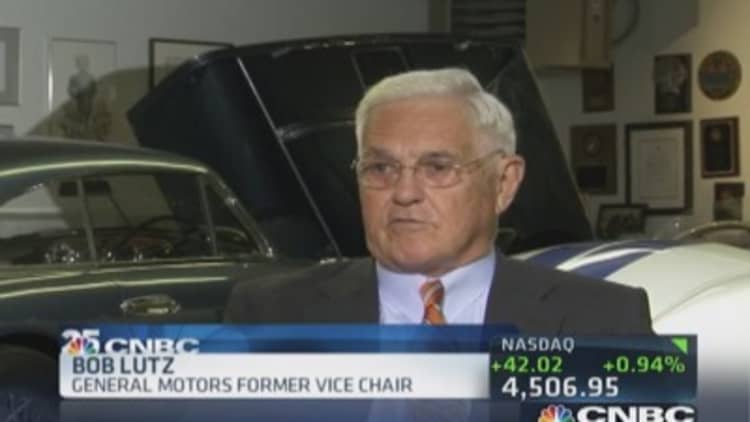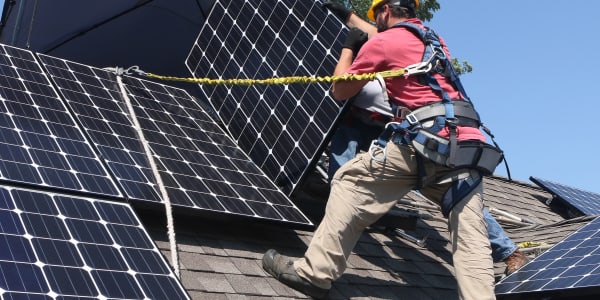
Electric vehicles are generating more buzz in the auto industry as the years go by. But looking 25 years into the future, analysts' opinions vary greatly over how much influence these vehicles will have on drivers and automakers.
Bob Lutz, former vice chairman of General Motors, predicts that by 2039, almost all private transportation will be done by electric vehicles.
Kevin Riddell, manager of powertrain forecasting at LMC Automotive, said gas-powered vehicles may not have the near 100 percent penetration they have now, but they will likely still make up 50 to 75 percent of the market.
Tom Kloza, chief oil analyst at GasBuddy.com, said gasoline will be "king of the kingdom" for the next 10 to 15 years, but beyond that, it's too hard to predict.
Welcome to the great debate over the future of electric vehicles.
The 'sizzle and fizzle' effect
One reason for the wide range of estimates is uncertainty over levels of investment.
Today, Navigant Research estimates there are 200,000 pure electric vehicles amid the roughly 242 million vehicles in America, or 0.08 percent, with just over 1 million charging stations.
But most of today's EVs were bought, in part, with the assistance of state and federal tax credits. Uncle Sam has also made a healthy investment in the electric vehicle infrastructure by subsidizing the construction of charging stations.
Researchers with the MIT Sloan School of Management estimate battery electric vehicles could reach only 3.7 percent of all vehicle sales in 2040 if the auto industry, state and federal governments and the public maintain their current levels of investment.
Read MoreElectric car batteries pass latest crash tests
But they could soar to 50 percent of all vehicle sales by that time if there's a coordinated effort to push EVs. In short, for electric cars to truly take off, more money needs to be spent.
"You need a combination of positive influences from each one of these for the EV market to finally pick up," said Claire Weller, one of the MIT researchers. "Individually, they are not sufficient to support the EV market in the long term."
Researchers said risk also lies in the fact that electric vehicles are a prime candidate for what they call the "sizzle and fizzle" effect—when there's initial enthusiasm for a technology but it struggles to hold over the long term.
Search for range, low costs
At the heart of the question about how quickly electric vehicles will gain popularity is when automakers will design lithium-ion batteries that go farther at a far lower cost.
Right now, the most popular mass market electric car, the Nissan Leaf, can go 80 to 90 miles on a full charge. The Model S, a luxury pure electric car, has a far greater range of closer to 300 miles. But drivers pay for that range by getting a car with a larger, more powerful and much more expensive battery pack.
Read MoreTesla to open up patents
The Chevy Volt, a range-extended electric car that has a gas-assist engine, offers owners the first 38 miles all-electric before the gas-assist engine kicks in, giving the driver up to another 342 miles.
They are the best-selling electric cars in America and symbolize the challenge facing automakers: to give EV owners more range, they have put in more expensive battery packs. Further complicating their efforts is the fact that bigger battery packs are heavier and weigh on the car's range.
Lutz predicts these issues will be resolved over the next decade.
"With these advanced batteries, in 10 to 15 years a car like a Chevy Volt will go 400 miles," he said. "If you have 400 miles electric who needs a gasoline engine anymore?"
Read MoreHow Apple and Google will invade your car
Tesla CEO Elon Musk is hoping battery costs will drop and their range will grow when the company opens a Gigafactory in 2017 to ramp up production of lithium-ion battery cells. Tesla has also said it will release all of its patents in hopes of spurring greater development of electric vehicles by other companies. Both moves are geared toward one goal: sparking a surge in electric vehicles.
Gas-powered and not going away
Nonetheless, many in the auto industry said the vehicles most Americans drive today will likely be what they're driving 25 years from now. Gas-powered cars may remain the primary choice for many Americans because they're familiar with them, and the mileage on those vehicles is expected to continue to climb.
"I wouldn't be surprised to start seeing 60 miles per gallon or 70 miles per gallon in some of the [gas-powered] vehicles that they are going to produce 25 years from now," Riddell said.
The Union of Concerned Scientists estimates the U.S. could cut its oil consumption by 4 million barrels a day by 2035 if it stays on track and doubles fuel economy standards by 2025 to an auto fleet average of 54.5 miles per gallon.
Read MoreTake the wheel please, I'm done driving
That would equal cheaper gas for drivers. And as internal combustion engines become more efficient, automakers and those invested in the oil and gas industry will also push the convenience of filling up in minutes and drivers' ability to go where they want at any time.
"With an electric vehicle right now, you pull in, you refuel and it takes over a half an hour to recharge for, you know, 70 or 80 miles in some vehicles, and that really makes people feel uncomfortable," Riddell said.
—By CNBC's Phil LeBeau





